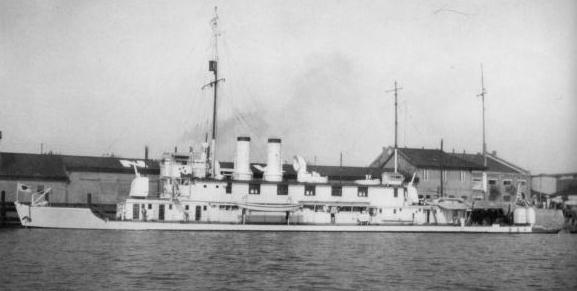©2011 Bob Hackett and Sander Kingsepp
Revision 1
17 February 1921:
Named KATATA. [1]
29 April 1922:
Aioi. Laid down at the Harima shipyard.
16 July 1922:
Launched then disassembled in sections and shipped to Shanghai, China. [2]
25 January 1923:
Shanghai. Re-laid down and reassembled at Tunghwa Shipbuilding.
20 October 1923:
Completed. LtCdr Tsuchiya M. is appointed Commanding Officer.
5 February 1924:
LtCdr (later Vice Admiral) Suga Hikojiro (38) is appointed CO.
21 June 1924:
LtCdr (later Vice Admiral) Goto Eiji (37) is appointed CO.
15 July 1924:
An unknown officer is appointed CO.
10 May 1928:
Lt Cdr/Cdr Suga Hikojiro is again appointed CO.
15 January 1930:
Lt Cdr (later Vice Admiral) Ito Kenzo (41) is appointed CO.
28 January 1932:
LtCdr (later Vice Admiral) Kimura Masatomi (41) is appointed CO.
20 September 1932:
Cdr (later Rear Admiral) Matsura Tadayuki (40) is appointed CO.
15 November 1933:
An unknown officer is appointed CO.
7 July 1937: The Marco Polo Bridge (The"First China Incident") Incident:
Hun River, Lukuokiao (Peking), China. Japanese troops at the bridge fire blank cartridges during night maneuvers. Chinese troops fire back. Later, the Japanese discover a soldier missing. They demand entry to the Peking (Beijing) suburb of Wanping to look for him, but the Chinese refuse. The Japanese shell the city and an undeclared war on China begins.
July 1937:
Japanese residents in the Yangtze River area are guarded by Rear Admiral (later Vice Admiral) Tanimoto Umataro’s (35) 11th Gunboat Division including KATATA based at Shanghai.
29 July 1937:
The Japanese capture the ancient Imperial Chinese capital of Peking (now Beijing).
July-early August 1937:
The other gunboats of the 11th Gunboat Division evacuate Japanese civilians from the interior to Shanghai.
13 August 1937: The Second Battle of Shanghai
Shanghai. At 0900, more than 10,000 Japanese troops enter the suburbs. Fighting begins in the Zhabei, Wusong and Jiangwan districts. KATATA and the 11th Gunboat Division put ashore Special Naval Landing Force (SNLF) reinforcements. At 1600, warships of Vice Admiral (later Admiral) Hasegawa Kiyoshi’s (31)(former CO of NAGATO) 3rd Fleet in the Huangpu (Whangpoa) and Yangtze Rivers begin bombarding Chinese shore positions.
14 August 1937 - "Bloody Saturday":
Shanghai. Flagship USS AUGUSTA (CA-31), carrying Admiral Harry E. Yarnell (former CO of SARATOGA, CV-3), CINC, U.S. Asiatic Fleet, arrives from Tsingtao and anchors in the Huangpu River. That same day, the Chinese Air Force (CAF), under retired Captain (later LtGen) Claire L. Chennault, launches aircraft to attack IJN flagship IZUMO and the Japanese fleet. The CAF mistakenly bombs British cruiser HMS CUMBERLAND, but their bombs fall wide. Two bombs also fall close alongside AUGUSTA, but no one is killed. Other CAF fliers also bomb Shanghai city, killing more than 1,700 civilians and wounding 1800 others.
19 August 1937:
In view of the increasing danger, it is decided to repatriate Shanghai’s Japanese women and children. About 20,000 of the total 30,000 residents are successively returned home.
23 August 1937:
50 km NE of Shanghai. The IJN lands General Matsui Iwane's 3rd, 8th, and 11th Divisions at Chuanshakou, Shizilin, and Baoshan under the cover of the 3rd Fleet's guns. The IJN also makes other large-scale landings of Matsui's troops at Liuhe, Wusong and Chuanshakou.
25 October 1937:
Chinese troops begin withdrawl from parts of Shanghai.
5-12 November 1937 - The Fall of Shanghai:
S of Shanghai. The IJN lands the IJA 10th Army in Jinshanwei, nearly unopposed. On 8 November, Generalissimo Chiang Kai-shek issues an order for a general retreat. By 12 November, Shanghai is cleared of Chinese troops. On 26 November, the Chinese Army fall backs to the capital of Nanjing (Nanking); thus the battle for Shanghai lasted three months.
1 December 1937:
Rear Admiral (later Vice Admiral) Kondo Eijiro (36)(former CO of KAGA) is appointed CO of the 11th Gunboat Division.
1 December 1938:
Cdr (later Rear Admiral) Saito Taizo (46) is appointed CO.
Ca. 1940:
Rearmed with dual 3.1-inch/40 cal. AA and five 13.2 mm mgs.
15 April 1940:
An unknown officer is appointed CO.
December 1941:
Attached to the First China Expeditionary Fleet, China Area Fleet.
22 June 1942: Operation SE (SE-Go Sakusen):
KATADA and river gunboats SUMIDA and SETA and four small unidentified gunboats are attached to the Tung-Ting Lake Force, one of several forces participating in Operation SE.
Ca. 1943/1944:
KATATA’s five 13.2 mm mgs are landed and replaced with six Type 96 25 mm AA guns.
20 August 1943:
The First China Expeditionary Fleet is deactivated. Attached to the Yangzte Special Base Force, China Area Fleet.
10 October 1944:
Attached to the Yangtze Area Special Base Force’s 21st Gunboat Division with gunboat SETA.
12 December 1944:
Yangtze River. USAAF aircraft bomb and damage (possibly sunk and salvaged) KATATA near Kiukiang, China at 29-35N, 116-10E. Towed to Shanghai.
Early 1945:
KATATA’s useable armament is shipped ashore for use in land defenses.
2 April 1945:
Shanghai. USAAF P-51 “Mustang” fighter bombers bomb and damage KATATA.
15 August 1945:
Shanghai. KATATA is unnavigable when notice is received of the end of the war.
1945:
Ceded to the Republic of China as a war reparation.
3 May 1947:
Removed from the Navy List. Later, dismantled and scrapped.
Author's Notes:
[1] Also known as KATADA.
[2] Because the draft of this type of boat was so shallow, even when the seas were a little high, there was a great danger of turning over, so it was transported disassembled and re-assembled at its operating locale.
Thanks go to Matthew Jones for help in identifying COs.
-Bob Hackett and Sander Kingsepp
Back to
Gunboat Page



